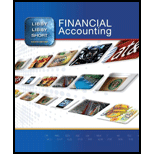
Financial Accounting, 8th Edition
8th Edition
ISBN: 9780078025556
Author: Robert Libby, Patricia Libby, Daniel Short
Publisher: McGraw-Hill Education
expand_more
expand_more
format_list_bulleted
Question
Chapter 2, Problem 4AP
To determine
Indicate whether each of given item is an investing (I) or financing (F), also indicate effect on the
Expert Solution & Answer
Want to see the full answer?
Check out a sample textbook solution
Students have asked these similar questions
Can you help me solve this financial accounting question using valid financial accounting techniques?
General Accounting
Please explain the correct approach for solving this financial accounting question.
Chapter 2 Solutions
Financial Accounting, 8th Edition
Ch. 2 - Prob. 1QCh. 2 - Define the following: a. Asset b. Current asset c....Ch. 2 - Prob. 3QCh. 2 - Why are accounting assumptions necessary?Ch. 2 - For accounting purposes, what is an account?...Ch. 2 - What is the fundamental accounting model?Ch. 2 - Prob. 7QCh. 2 - Explain what debit and credit mean.Ch. 2 - Prob. 9QCh. 2 - Prob. 10Q
Ch. 2 - Prob. 11QCh. 2 - Prob. 12QCh. 2 - How is the current ratio computed and interpreted?Ch. 2 - Prob. 14QCh. 2 - Prob. 1MCQCh. 2 - Which of the following is not an asset? a....Ch. 2 - Total liabilities on a balance sheet at the end of...Ch. 2 - The dual effects concept can best be described as...Ch. 2 - The T-account is a tool commonly used for...Ch. 2 - Prob. 6MCQCh. 2 - The Cash T-account has a beginning balance of...Ch. 2 - Prob. 8MCQCh. 2 - At the end of a recent year, The Gap, Inc.,...Ch. 2 - Prob. 10MCQCh. 2 - Prob. 1MECh. 2 - Matching Definitions with Terms Match each...Ch. 2 - Identifying Events as Accounting Transactions...Ch. 2 - Classifying Accounts on a Balance Sheet The...Ch. 2 - Prob. 5MECh. 2 - Prob. 6MECh. 2 - Prob. 7MECh. 2 - Prob. 8MECh. 2 - Prob. 9MECh. 2 - Prob. 10MECh. 2 - Prob. 11MECh. 2 - Prob. 12MECh. 2 - Prob. 13MECh. 2 - Prob. 1ECh. 2 - Prob. 2ECh. 2 - Prob. 3ECh. 2 - Prob. 4ECh. 2 - Determining Financial Statement Effects of Several...Ch. 2 - Prob. 6ECh. 2 - Prob. 7ECh. 2 - Analyzing the Effects of Transactions In...Ch. 2 - Prob. 9ECh. 2 - Prob. 10ECh. 2 - Prob. 11ECh. 2 - Prob. 12ECh. 2 - Prob. 13ECh. 2 - Prob. 14ECh. 2 - Prob. 15ECh. 2 - Prob. 16ECh. 2 - Inferring Typical Investing and Financing...Ch. 2 - Prob. 18ECh. 2 - Prob. 19ECh. 2 - Prob. 20ECh. 2 - Identifying Accounts on a Classified Balance Sheet...Ch. 2 - Prob. 2PCh. 2 - Prob. 3PCh. 2 - Prob. 4PCh. 2 - Prob. 5PCh. 2 - Prob. 6PCh. 2 - Prob. 1APCh. 2 - Prob. 2APCh. 2 - Prob. 3APCh. 2 - Prob. 4APCh. 2 - Prob. 1CPCh. 2 - Prob. 2CPCh. 2 - Prob. 3CPCh. 2 - Prob. 4CPCh. 2 - Prob. 5CPCh. 2 - Prob. 6CPCh. 2 - Prob. 7CPCh. 2 - Prob. 8CPCh. 2 - Prob. 1CC
Knowledge Booster
Similar questions
- Can you help me solve this general accounting problem using the correct accounting process?arrow_forwardWhat type of account is 'Unearned Revenue'?A) AssetB) LiabilityC) EquityD) Revenue need explarrow_forwardneed help!!What type of account is 'Unearned Revenue'?A) AssetB) LiabilityC) EquityD) Revenuearrow_forward
- Please explain the solution to this general accounting problem using the correct accounting principles.arrow_forwardCan you demonstrate the proper approach for solving this financial accounting question with valid techniques?arrow_forwardI need guidance with this financial accounting problem using the right financial principles.arrow_forward
arrow_back_ios
SEE MORE QUESTIONS
arrow_forward_ios
Recommended textbooks for you

 AccountingAccountingISBN:9781337272094Author:WARREN, Carl S., Reeve, James M., Duchac, Jonathan E.Publisher:Cengage Learning,
AccountingAccountingISBN:9781337272094Author:WARREN, Carl S., Reeve, James M., Duchac, Jonathan E.Publisher:Cengage Learning, Accounting Information SystemsAccountingISBN:9781337619202Author:Hall, James A.Publisher:Cengage Learning,
Accounting Information SystemsAccountingISBN:9781337619202Author:Hall, James A.Publisher:Cengage Learning, Horngren's Cost Accounting: A Managerial Emphasis...AccountingISBN:9780134475585Author:Srikant M. Datar, Madhav V. RajanPublisher:PEARSON
Horngren's Cost Accounting: A Managerial Emphasis...AccountingISBN:9780134475585Author:Srikant M. Datar, Madhav V. RajanPublisher:PEARSON Intermediate AccountingAccountingISBN:9781259722660Author:J. David Spiceland, Mark W. Nelson, Wayne M ThomasPublisher:McGraw-Hill Education
Intermediate AccountingAccountingISBN:9781259722660Author:J. David Spiceland, Mark W. Nelson, Wayne M ThomasPublisher:McGraw-Hill Education Financial and Managerial AccountingAccountingISBN:9781259726705Author:John J Wild, Ken W. Shaw, Barbara Chiappetta Fundamental Accounting PrinciplesPublisher:McGraw-Hill Education
Financial and Managerial AccountingAccountingISBN:9781259726705Author:John J Wild, Ken W. Shaw, Barbara Chiappetta Fundamental Accounting PrinciplesPublisher:McGraw-Hill Education


Accounting
Accounting
ISBN:9781337272094
Author:WARREN, Carl S., Reeve, James M., Duchac, Jonathan E.
Publisher:Cengage Learning,

Accounting Information Systems
Accounting
ISBN:9781337619202
Author:Hall, James A.
Publisher:Cengage Learning,

Horngren's Cost Accounting: A Managerial Emphasis...
Accounting
ISBN:9780134475585
Author:Srikant M. Datar, Madhav V. Rajan
Publisher:PEARSON

Intermediate Accounting
Accounting
ISBN:9781259722660
Author:J. David Spiceland, Mark W. Nelson, Wayne M Thomas
Publisher:McGraw-Hill Education

Financial and Managerial Accounting
Accounting
ISBN:9781259726705
Author:John J Wild, Ken W. Shaw, Barbara Chiappetta Fundamental Accounting Principles
Publisher:McGraw-Hill Education